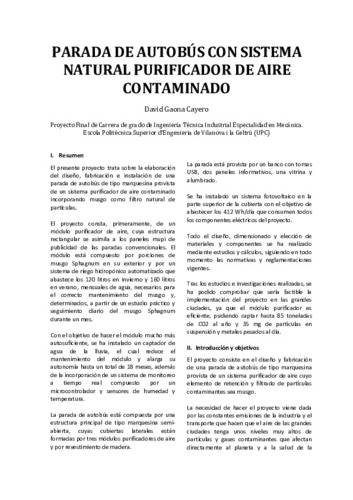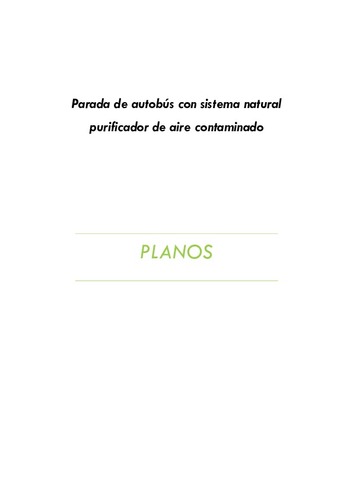Mostra el registre d'ítem simple
Parada de autobús con sistema natural purificador de aire contaminado
| dc.contributor | López Membrilla, Manuel |
| dc.contributor.author | Gaona Cayero, David |
| dc.contributor.other | Universitat Politècnica de Catalunya. Departament d’Enginyeria Gràfica i de Disseny |
| dc.date.accessioned | 2021-09-14T09:11:36Z |
| dc.date.available | 2021-09-14T09:11:36Z |
| dc.date.issued | 2021-07-06 |
| dc.identifier.uri | http://hdl.handle.net/2117/351238 |
| dc.description.abstract | El presente proyecto trata sobre la elaboración del diseño, fabricación e instalación de una parada de autobús de tipo marquesina provista de un sistema purificador de aire contaminado incorporando musgo como filtro natural de partículas. La necesidad de hacer el proyecto viene dada por las constantes emisiones de la industria y el transporte que hacen que el aire de las grandes ciudades tenga unos niveles muy altos de partículas y gases contaminantes que afectan directamente al planeta y a la salud de la población. Por otro lado, la idea de utilizar musgo como filtro natural parte del conocimiento de que algunas especies de briofitas tienen la capacidad de desarrollarse en entornos muy desfavorables, además de tener unas capacidades de resistencia muy elevadas y un sistema de crecimiento basado en la metabolización de partículas contaminantes. Los principales objetivos que se buscan son: la reducción de la contaminación en las ciudades, el aprovechamiento de la infraestructura de la vía pública y la eficiencia energética y la sostenibilidad. El proyecto consta, primeramente, de un módulo purificador de aire, cuya estructura rectangular se asimila a los paneles mupi de publicidad de las paradas convencionales. El módulo está compuesto por porciones de musgo Sphagnum en su exterior y por un sistema de riego hidropónico automatizado que abastece los 120 litros en invierno y 160 litros en verano, mensuales de agua, necesarios para el correcto mantenimiento del musgo y, determinados, a partir de un estudio práctico y seguimiento diario del musgo Sphagnum durante un mes. Con el objetivo de hacer el módulo mucho más autosuficiente, se ha instalado un captador de agua de la lluvia, el cual reduce el mantenimiento del módulo y alarga su autonomía hasta un total de 18 meses, además de la incorporación de un sistema de monitoreo a tiempo real compuesto por un microcontrolador y sensores de humedad y temperatura. La parada de autobús está compuesta por una estructura principal de tipo marquesina semi-abierta, cuyas cubiertas laterales están formadas por tres módulos purificadores de aire y por revestimiento de madera. La parada está provista por un banco con tomas USB, dos paneles informativos, una vitrina y alumbrado. Se ha instalado un sistema fotovoltaico en la parte superior de la cubierta con el objetivo de abastecer los 412 Wh/día que consumen todos los componentes eléctricos del proyecto. Todo el diseño, dimensionado y elección de materiales y componentes se ha realizado mediante estudios y cálculos, siguiendo en todo momento las normativas y reglamentaciones vigentes. Como conclusión, tras los estudios e investigaciones realizados, se ha podido comprobar que sería factible la implementación del proyecto en las grandes ciudades, ya que el módulo purificador es eficiente, pudiendo captar hasta 85 toneladas de CO2 al año y 35 mg de partículas en suspensión y metales pesados al día. Por otro lado, el proyecto puede servir para incentivar el uso de energías renovables, la sostenibilidad y la reducción de emisiones y gasto energético y concienciar a la sociedad de que el planeta se encuentra en un estado crítico y la ingeniería toma un papel destacado para poder solventarlo con el uso de las nuevas tecnologías y la innovación. |
| dc.description.abstract | This project consists of the development of the design, manufacture and installation of a marquee type bus stop equipped with a polluted air purifying system incorporating moss as a natural particle filter. The need to carry out the project is given by the constant emissions from industry and transport that cause the air in large cities to have very high levels of polluting particles and gases that directly affect the planet and the health of the population. On the other hand, the idea of using moss as a natural filter stems from the knowledge that some species of bryophytes can develop in very unfavorable environments, in addition to having very high resistance capacities and a growth system based on the metabolization of polluting particles. The main objectives of the project are the reduction of pollution in cities, take advantage of the public infrastructure and energy efficiency and sustainability. The project consists, firstly, of an air purifying module, whose rectangular structure is like the advertising mupi panels of conventional bus-stops. The module is composed of portions of Sphagnum moss on the outside and an automated hydroponic irrigation system that provides 120 liters in winter and 160 liters in summer, monthly of water, necessary for the correct maintenance of the moss and, determined from of a practical study and daily monitoring of Sphagnum moss for one month. With the objective of make the module much more self-sufficient, a rainwater collector has been installed, which reduces the maintenance of the module and extends its autonomy to a total of 18 months. In addition, it incorporates a real time monitoring system composed of a microcontroller and humidity and temperature sensors. The bus stop is made up of a main structure of semi-open marquee type, whose side covers are made up of three air purifying modules and wooden cladding. The bus stop is provided by a bench with USB sockets, two information panels, a showcase and lighting. A photovoltaic system has been installed in the upper part of the roof to supply the 412 Wh / day consumed by all the electrical components of the project. All the design, dimensioning and choice of materials and components has been carried out by studies and calculations, always following the rules and regulations required. In conclusion, after the studies and research carried out, it has been found that the implementation of the project in large cities would be feasible, since the purifier module is efficient, being able to capture up to 85 tons of CO2 per year and 35 mg of suspended particles and heavy metals per day. On the other hand, the project can serve to encourage the use of renewable energies, sustainability and the reduction of emissions and energy expenditure and raise awareness in society that the planet is in a critical state and engineering plays a prominent role to be able to solve it with the use of new technologies and innovation. |
| dc.language.iso | spa |
| dc.publisher | Universitat Politècnica de Catalunya |
| dc.rights | Attribution 3.0 Spain |
| dc.rights.uri | http://creativecommons.org/licenses/by/3.0/es/ |
| dc.subject | Àrees temàtiques de la UPC::Enginyeria mecànica |
| dc.subject | Àrees temàtiques de la UPC::Desenvolupament humà i sostenible::Degradació ambiental::Contaminació atmosfèrica |
| dc.subject.lcsh | Bus stops |
| dc.subject.lcsh | Air -- Purification |
| dc.subject.other | Parada de autobús |
| dc.subject.other | Contaminación |
| dc.subject.other | Módulo purificador de aire |
| dc.subject.other | Musgo |
| dc.subject.other | Energías renovables |
| dc.subject.other | Sostenibilidad |
| dc.subject.other | Ciudades |
| dc.subject.other | Captador de partículas |
| dc.subject.other | Salud |
| dc.subject.other | Autosuficiencia |
| dc.subject.other | Bus stop |
| dc.subject.other | Pollution |
| dc.subject.other | Air purifier module |
| dc.subject.other | Moss |
| dc.subject.other | Renewable energies |
| dc.subject.other | Sustainability |
| dc.subject.other | Cities |
| dc.subject.other | Particle collector |
| dc.subject.other | Population |
| dc.subject.other | Health |
| dc.title | Parada de autobús con sistema natural purificador de aire contaminado |
| dc.type | Bachelor thesis |
| dc.subject.lemac | Autobusos -- Parades |
| dc.subject.lemac | Aire -- Depuració |
| dc.identifier.slug | PRISMA-158531 |
| dc.rights.access | Open Access |
| dc.date.updated | 2021-07-14T18:34:02Z |
| dc.audience.educationlevel | Grau |
| dc.audience.mediator | Escola Politècnica Superior d'Enginyeria de Vilanova i la Geltrú |
| dc.audience.degree | GRAU EN ENGINYERIA MECÀNICA (Pla 2009) |
| dc.description.sdg | Objectius de Desenvolupament Sostenible::3 - Salut i Benestar::3.9 - Per a 2030, reduir substancialment el nombre de morts i malalties causats per productes químics perillosos i la pol·lució de l’aire, l’aigua i el sòl |
| dc.description.sdg | Objectius de Desenvolupament Sostenible::11 - Ciutats i Comunitats Sostenibles::11.6 - Per a 2030, reduir l’impacte ambiental negatiu per capita de les ciutats, amb especial atenció a la qualitat de l’aire, així com a la gestió dels residus municipals i d’altre tipus |




